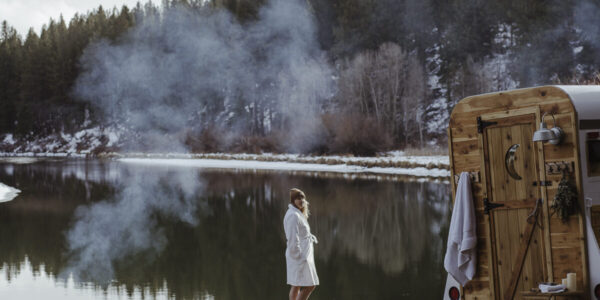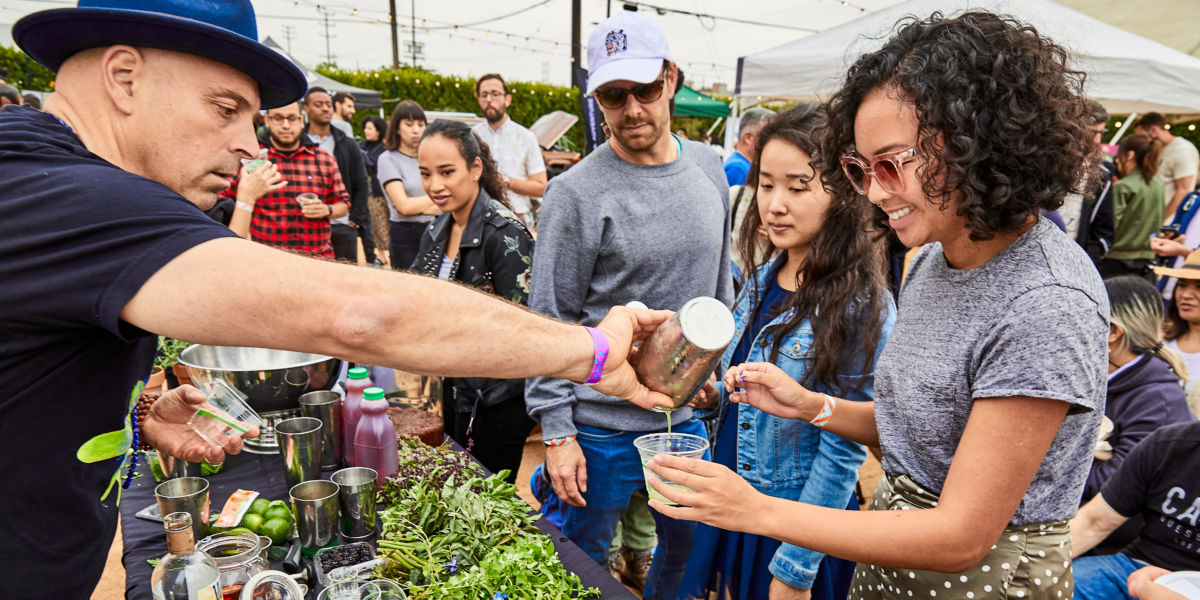
How to Mix the Bounty of Nature into the Wildest Cocktails Ever
These cocktails come from the forest floor and the farmers market, not from a bottle.

Courtesy of Outpost LA
Watching famed SoCal mixologist Matthew Biancaniello spread a forest of green across the Camp Sunset lounge table at the recent cultural expo Outpost LA, I start expecting a gardening or foraging demonstration. Tiny terra cotta pots of rosemary, little ruby strawberries, a profusion of jewel-toned flowers and green herbs, and nopales leaves in a jar blanket the table.
But instead of shovels and weeders, Biancaniello whips out shakers, strainers, and bar spoons, and then throws his greenery into the shakers. Using borage, society garlic, calendulum, corn flowers, and mini marigolds, he pours tiny drinks for his captivated audience. Nopales soaked in unaged whiskey form the base for a lime cocktail that’s simultaneously light from the lime and nopal, and substantial from the whiskey.
https://www.instagram.com/p/BhKaqb8Bg18/This magic act is the same wild rebellion that Biancaniello has performed every week at the Hollywood Roosevelt Hotel for years. While other bartenders rely on just a couple types of citrus and herbs to get them through a long night of mojitos and G&T’s, Biancaniello needs much, much more. As a “cocktail chef” who creates libations that are more food than drink, his book Eat Your Drink: Culinary Cocktails guides you toward concoctions that are more than just a combo of conventional spirits, citrus, and sugar.
That “more,” it turns out, comes straight from Biancaniello’s remarkably self-driven thirst to learn about and experiment with every herb, flower, vegetable, and fruit he comes across. From studying under the tutelage of brilliant wild food forager Pascal Baudar to spending $8,000 of his own funds experimenting with herbs, ice, and alcohol over the years, Biancaniello has far surpassed a professional passion for liquid cooking—it’s fair to say he is obsessed.
“Once you just look around, this stuff is everywhere,” Biancaniello says. “Things from the wild are so much more intense in flavor and really go a long way, such as sages. Once you do something and you understand it, it opens this whole world up for you. If you show me just once, watch out, forget it, I’m going to go crazy.”
https://www.instagram.com/p/BclFibtjisA/Case in point: What he does with a fistful of wild arugula before our very eyes at the Camp Sunset lounge. The fistful is plentiful, and the muddling is vigorous. His work is less a delicate flourish of mixology and more like grinding flour in a mill. To his shaker, he adds three-quarters of an ounce of fresh lime juice and three-quarters of an ounce of agave syrup, plus two ounces of gin, which he shakes. He garnishes the cocktail with vividly bluish-purple borage flowers, which he claims taste like a cross between an oyster and a cucumber—they do, in fact so much so that the taste is startling and a little disturbing at first.
To get these rare ingredients, like borage flowers, lovage, purple basil, and Gaviota strawberries from Oxnard, Biancaniella heads to the Santa Monica Farmers Market every Wednesday—a market he esteems “the greatest in the world.” There, he gets the ingredients for his Heirloom Tomato Mojito, which combines mint and the summer’s ripest heirlooms, and his Last Tango in Modena, which brings together 25-year-aged balsamic vinegar and strawberries.
https://www.instagram.com/p/Bq7q1t3hSz1/The bartender also forages in the Santa Monica mountains near his former Topanga Canyon cabin, frequently gathering wild bay leaf, wild watercress, water mint, California laurel bay, mustard seeds, and different kinds of sages. He’s careful to follow logistical and spiritual rules of the wild, never taking more than twenty percent. He’s collected wild green walnuts and wild herbs for his nocino, a wild take on the nutty Italian liqueur.
He talks lovingly about the bounty nature can offer: “Look at the colors of those borage flowers, could you ever dream up a better garnish. I feel so connected to the earth and what nature provides. It’s all right there—you don’t really have to do much except go outside.”
https://www.instagram.com/p/BrA2s80BaTH/Biancaniello has three recommendations for those mixing experimentally with herbs and vegetables at home.
Stick to Proportions
“It will be almost impossible for you not to balance a drink if you keep the formula of three-quarters ounce sugar, three-quarters ounce fresh lime or lemon, two ounces spirit.”
Pick 1 Ingredient, Make It 5-6 Different Ways
“Infuse, make it into a foam, muddle it, make it into an oil, turn it into an ice. Once you understand you can take something without $7,000 of equipment and morph it into something else, it’s not just basil anymore.”Muddle, Muddle, Muddle
This gets the flavors out. “The spirits, sugar, citrus—you switch those three things up and muddle—just crush these flavors into the drink,” he says.